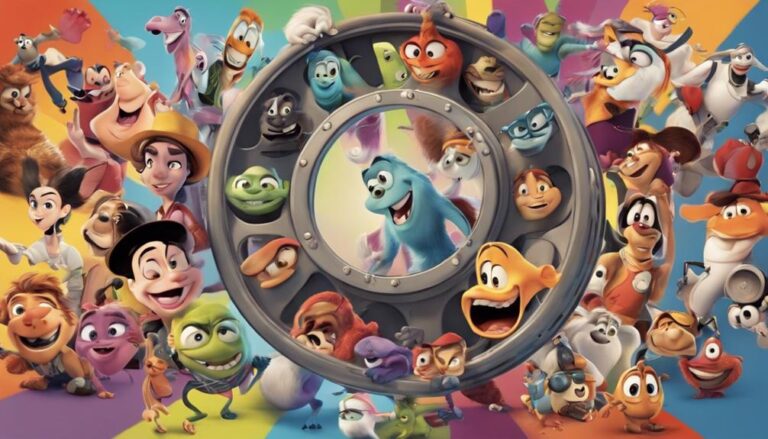Why Cartoon Characters Need Emotional Depth
As you sit down to watch your favorite cartoon, you might find yourself wondering what makes certain characters stick with you long after the credits roll. It's not just their bright colors or catchy theme songs – it's the emotional depth that makes them relatable and, dare you say, real. When cartoon characters exhibit emotional intelligence, flaws, and authenticity, they transcend their two-dimensional existence and resonate with you on a deeper level. But what exactly makes emotional depth so vital, and how can it elevate the world of animation?
Key Takeaways
- Emotional depth makes cartoon characters relatable, allowing audiences to connect with them on a deeper level and invest in their stories.
- Authentic emotional expressions create realistic portrayals of characters' reactions, avoiding forced humor and over-the-top reactions.
- Cartoon characters with emotional intelligence become more than just colorful drawings, exhibiting empathy and understanding towards others.
- Emotional imperfections make heroic moments more earned and satisfying, creating imperfect role models that resonate with audiences.
Emotional Intelligence in Cartoons
As you immerse yourself in your favorite cartoons, you start to notice that the most memorable characters are those who exhibit emotional intelligence, understanding and regulating their own emotions while empathizing with others. They're the ones who make you laugh, cry, and root for them until the very end. These characters have emotional resonance, a quality that makes their experiences feel authentic and relatable.
Take, for instance, the character of Marceline the Vampire Queen from Adventure Time. Her struggles with her past, her relationships, and her own identity create a rich character nuance that draws you in. You see yourself in her emotions, her fears, and her desires. Her emotional intelligence allows her to navigate complex situations, making her a compelling and believable character.
When cartoon characters possess emotional intelligence, they become more than just colorful drawings on a screen. They become real people with real feelings, and that's what makes them unforgettable. By investing in characters with emotional depth, creators can craft stories that resonate with audiences on a deeper level, leaving a lasting impact long after the credits roll.
The Power of Relatable Flaws
You find yourself drawn to characters like Steven Universe's Garnet, who struggles with the weight of her responsibilities, because her relatable flaws make her heroic moments all the more earned and satisfying.
It's not just that she's powerful or wise; it's that she's also vulnerable and struggling to keep it together. You see yourself in her human imperfections, and that connection makes her triumphs all the more meaningful.
When cartoon characters exhibit relatable flaws, they become imperfect rolemodels that resonate with us on a deeper level.
We're not just watching a superhero save the day; we're watching someone who's just like us, with the same fears and doubts, overcome their own limitations to achieve greatness. This authenticity makes their victories feel more authentic, more earned, and more inspiring.
Beyond Stereotypes and Tropes
As you craft your cartoon character, you're likely tempted to rely on familiar stereotypes and tropes to quickly convey their personality.
But think about it – don't you want your character to stand out from the crowd, to surprise and intrigue your audience?
Breaking the Mold
Shatter the mold by crafting characters who defy expectations, trading tired tropes for complex personalities that captivate audiences.
You're not bound by traditional norms; take creative liberties to shape unique traits, quirks, and backstories.
By doing so, you'll create characters that resonate with viewers on a deeper level.
Artistic freedom allows you to experiment with unconventional designs, mannerisms, and dialogue, making your characters truly one-of-a-kind.
When you break free from stereotypes, you open doors to fresh storylines and character arcs.
Imagine a brave and confident princess who's also clumsy and accident-prone, or a villain with a sympathetic motivation that makes them relatable.
These contradictions make characters more believable and interesting.
As you break the mold, remember that imperfections are what make us human.
Embrace the imperfections in your characters, and audiences will respond with empathy and investment.
Avoiding Clichés
Beyond stereotypes and tropes, clichés lurk in the shadows, waiting to sabotage your character's authenticity, so it's essential to confront and overcome them.
You've worked hard to craft a unique personality, but a single clichéd trait can reduce them to a predictable, one-dimensional caricature.
Don't let that happen! Instead, aim to add fresh perspectives to your character's emotional landscape.
Ask yourself, what makes them tick? What're their strengths and weaknesses? How do they respond to challenges and setbacks?
Building Empathy in Young Viewers
You watch your child's eyes widen as they witness their favorite cartoon character struggle with feelings of loneliness and rejection, sparking a sense of empathy that sets them on a path to understanding complex emotions.
This emotional connection is vital, as it lays the foundation for moral guidance and social learning.
When cartoon characters exhibit relatable emotions, children begin to develop a deeper understanding of others' perspectives. They start to recognize that everyone experiences similar feelings, regardless of their differences.
As a result, they become more empathetic and better equipped to navigate social situations. By witnessing their favorite characters work through emotional struggles, children learn valuable lessons about coping mechanisms, self-awareness, and relationships.
This emotional intelligence is essential for building strong, healthy relationships and making responsible decisions.
As a parent, it's heartening to see your child develop this emotional awareness, knowing it will benefit them throughout their lives.
Character Growth and Development
As you craft your cartoon characters, you're tasked with guiding them through pivotal moments that reshape their emotional landscapes.
You'll need to pinpoint the emotional turning points that spark growth, resolve inner conflicts that fuel their motivations, and guarantee their actions stay true to who they are.
Emotional Turning Points
During pivotal moments of their journey, cartoon characters encounter emotional turning points that challenge their worldview, forcing them to re-evaluate their motivations and desires.
These sudden revelations shake the foundation of their being, making them question everything they thought they knew. You see it in their eyes, the spark of realization that things aren't what they seemed. It's as if the character's entire perspective has been flipped upside down, leaving them disoriented but ripe for growth.
As you craft these emotional turning points, remember that they should be visually striking, conveying the character's emotional turmoil through their expressions, body language, and surroundings.
The environment can mirror their inner state, with stormy skies or crumbling landscapes reflecting their turmoil. These pivotal moments are opportunities to probe deeper into your character's psyche, exposing their vulnerabilities and fears.
Inner Conflict Resolution
With their emotional foundations shaken, cartoon characters must now confront the fractured pieces of their psyche, integrating the lessons learned from their emotional turning points into a renewed sense of self.
As you plunge deeper into their inner struggles, you'll witness a transformation that's both cathartic and empowering. This inner conflict resolution is vital, as it allows your characters to emerge stronger, wiser, and more self-aware.
Confronting mental turmoil: Your character must acknowledge and tackle their inner demons, rather than suppressing them.
Self-reflection and introspection: They must examine their thoughts, emotions, and actions to gain a deeper understanding of themselves.
Letting go of emotional baggage: By releasing the weight of past traumas or regrets, your character can move forward with a sense of liberation.
Forging a new sense of identity: As they integrate their lessons, they'll develop a more authentic, confident, and resilient sense of self.
Consistent Motivations
Consistent Motivations
By solidifying their motivations, you'll anchor your character's growth and development, ensuring their actions and decisions stay true to their evolving sense of self. This consistency helps you create a believable and relatable character arc. When your character's motivations are clear, you can craft authentic moral dilemmas that test their values and prompt inner struggles.
| Motivation | Action/Decision |
|---|---|
| Protecting friends | Sacrifices own safety to save others |
| Seeking revenge | Ignores moral code to punish enemy |
| Pursuing justice | Stands up to authority despite risks |
Authenticity in Animation Matters
You can't help but feel a sense of detachment when cartoon characters' emotions seem as flat as the screen they're projected on. It's like watching a puppet show, where the strings are visible and the emotions are forced. But when characters are given authentic emotional depth, it's like a veil is lifted, and you're transported into their world.
Realistic portrayals are essential, with characters reacting to situations in a way that's relatable and honest. No over-the-top reactions or forced humor.
Cultural sensitivity is also crucial, with characters' backgrounds and experiences respectfully represented, avoiding stereotypes and tropes.
Subtlety in expression is another key element, where a raise of an eyebrow or a slight smile can speak volumes about a character's emotions.
Consistency in behavior is vital, with characters acting in line with their personality and motivations, avoiding contradictions and plot holes.
When these elements come together, you're left with characters that feel like real people, not just caricatures. Their emotions resonate with you, and you become invested in their stories. That's when animation truly comes alive.
Frequently Asked Questions
Can Cartoon Characters Be Too Emotionally Intelligent for Young Audiences?
When you create a cartoon character that's too emotionally intelligent, you risk overwhelming young audiences with emotional overload. However, if you strike the right balance, their relatability soars, and kids can't help but connect with them on a deeper level.
Are Relatable Flaws in Characters Only for Comedic Effect?
You're wondering if relatable flaws in characters are only for comedic effect, but flawed heroes with tragic backstories, like Batman or Elsa, show that imperfections can make them more human and intriguing, not just laughable.
Do Cartoons Need to Tackle Complex Social Issues for Depth?
You're wondering if cartoons need to tackle complex social issues for depth. Yes, they do! Social commentary through realistic portrayals of characters' struggles makes their experiences more relatable and engaging, allowing you to form a deeper connection with them.
Can a Character's Emotional Depth Be Overpowered by Their Design?
You risk visual overload when a character's design dominates their personality, overpowering their emotional depth. If their appearance is too flashy or busy, it's hard to connect with their feelings, and design dominance takes over.
Are There Any Cultural Limitations to Emotional Depth in Cartoons?
When creating characters, you'll encounter cultural limitations to emotional depth, as certain stereotypes can be reinforced, adhering to cultural expectations that restrict complexity, making it harder for you to craft relatable, emotionally resonant characters.
Conclusion
As you watch your favorite cartoons, remember that the characters' emotional depth is what makes their stories stick with you long after the credits roll.
It's their relatable flaws, realistic portrayals, and authentic struggles that make them feel like real people, not just colorful drawings.
By investing in their emotional journeys, you're not just entertained – you're inspired to grow and develop alongside them.







